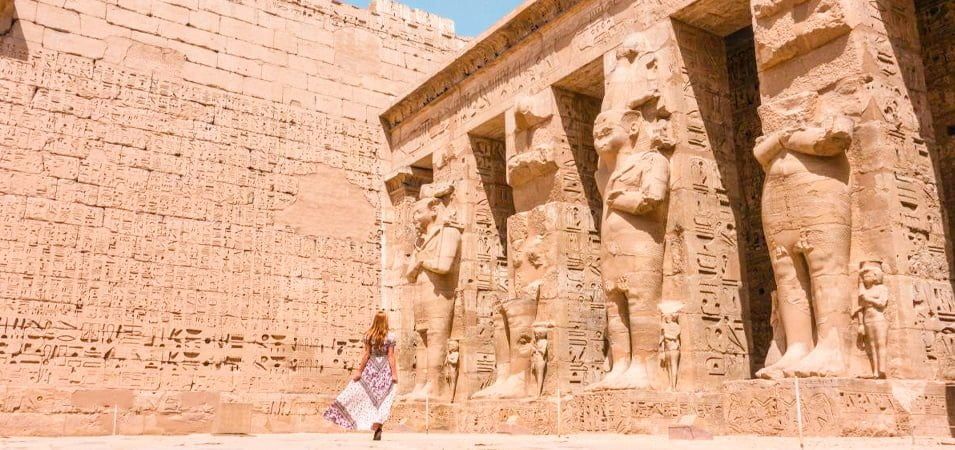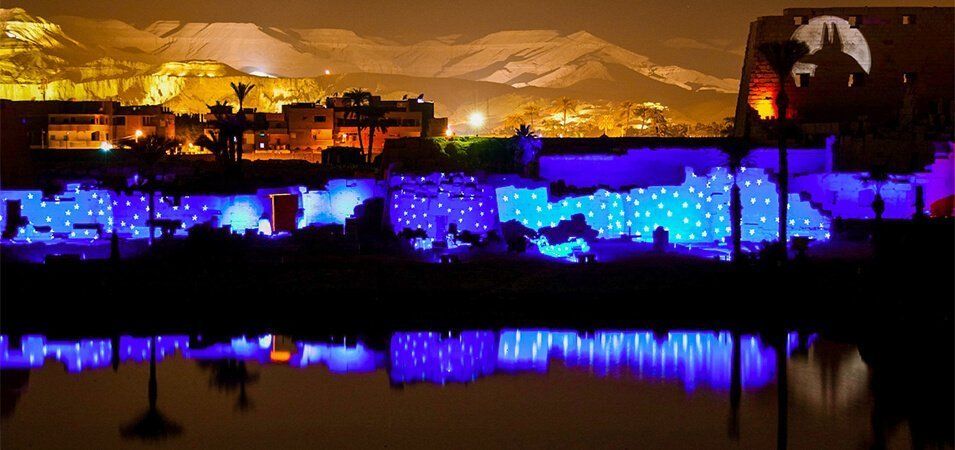Welcome to the fascinating world of Karnak Temple, an old place of worship that shows the glory of Egypt’s past. Step into a world with tall columns, complicated hieroglyphics, and sacred practices that have lasted for thousands of years. Karnak Temple is a reminder of what the pharaohs could do and how deeply spiritual the ancient Egyptians were. The unique Karnak Temple is in Luxor, Egypt. It is an ancient building with a lot of historical and scientific value. It is one of the most significant temple structures in the world, covering more than 100 hectares, and is a must-see for anyone interested in ancient Egypt. This piece will examine the Karnak Temple’s long history, beautiful architecture, and exciting stories.
Colossi of Memnon in Luxor: Unveiling the Ancient Marvels
Historical Significance of Karnak Temple

The ancient Egyptians gave the Karnak Temple a lot of importance in their history. It was built during the Middle Kingdom, and many pharaohs added to it over the years. It was the main place where people went to worship the Theban Triad, made up of Amun-Ra, Mut, and Khonsu. The temple was the site of many events, rituals, and processions that showed how deeply spiritual the ancient Egyptians were. Karnak Temple is a reminder of what the pharaohs could do and how much they cared about religion. It also gives us important information about the culture and religion of that time.
Architecture and Layout of Karnak Temple
Karnak Temple is impressive because of how it was built and set up. The Avenue of Sphinxes, the main gate, is over a mile long and makes a great way to get to the temple complex. The temple shows how skilled and well-made ancient Egyptian builders were. It has several precincts, each with pylons, courts, and sanctuaries. The most interesting building is the Great Hypostyle Hall, a vast room with tall columns and detailed paintings. The layout of the temple complex, with its significant buildings and straight lines, shows that the Egyptians knew a lot about architecture and were committed to building important sacred structures.
The Great Hypostyle Hall of Karnak Temple
The Great Hypostyle Hall is a remarkable feature of Karnak Temple. This vast hall is a forest of towering columns, creating a breathtaking sight for visitors. The entrance consists of 134 massive columns, with the central ones reaching a height of over 20 meters. These columns are intricately decorated with hieroglyphics and reliefs that depict scenes from ancient Egyptian mythology and religious rituals. Walking through the Great Hypostyle Hall is an awe-inspiring experience, as the grandeur of the towering columns and the play of light and shadow create a sense of wonder and reverence. It is a testament to the ancient Egyptians’ architectural genius and engineering prowess.
Obelisks of Karnak Temple
The Obelisks of Karnak are famous buildings that add to the temple complex’s appeal. These huge obelisks are made from a single piece of stone and stand tall to show power and religious loyalty. The Obelisk of Hatshepsut is one of the most famous obelisks. It was built to honor the great female pharaoh who ruled Egypt then. The obelisks, covered in complicated writing, tell us much about ancient Egypt’s history, beliefs, and successes. Their appearance in Karnak Temple reminds them of how much the ancient Egyptians valued symbols and how much they cared about building significant, impressive buildings.
Legends and Mythology

There are a lot of stories and myths about Karnak Temple that are fascinating. The walls and columns of the temple show scenes from Egyptian folklore that tell the stories of the pharaohs’ victories and the gods they worshipped. One interesting story is about the sacred lake in the temple complex. It was thought to have magical powers and was used in practices to clean people. These stories, which mix history and mythology, give us a glimpse into the spiritual beliefs and customs of the ancient Egyptians. When people visit Karnak Temple, they can get lost in these fascinating stories and learn more about the culture and symbols that made up ancient Egyptian society.
Excavation and Restoration
Over the years, much work has been done to excavate and fix up Karnak Temple to keep it looking beautiful. Archaeologists and historians work hard to find secret treasures, figure out what hieroglyphics mean, and put back together broken parts. Important artifacts and information about ancient Egyptian society have been found through careful digging. The goal of the restoration work has been to keep the temple’s structure in good shape and bring back its original beauty. Experts and skilled workers have carefully fixed and rebuilt damaged parts of Karnak Temple, ensuring that it will continue to amaze people and give them a glimpse into the past for many years. The history of this incredible temple complex is being kept safe by these ongoing efforts.
Visiting Karnak Temple
Seeing the Karnak Temple is a fascinating adventure that takes people back to ancient Egypt. When you explore the vast complex, you can see how grand the temple’s architecture is and learn about its long past. With the help of experienced guides, people can explore the temple’s intricate details and learn about the rituals, beliefs, and stories behind each structure. Walking through the vast halls and gardens decorated with hieroglyphics and tall columns fills you with awe and wonder. The spiritual atmosphere that lingers within the sacred walls of the temple gives visitors a unique chance to connect with the ancient past and enjoy the pharaohs’ lasting legacy.
Kom Ombo Temple: A Fascinating Ancient Egyptian Landmark
The Temples within Karnak Temple
There are several smaller temples inside the vast complex of Karnak Temple. Each of these temples has its own special meaning and artistic beauty. Even though these temples are smaller than the main complex, they add to the grandeur and religious importance of Karnak as a whole. Here are some of the most important temples inside Karnak:
- Temple of Amun-Ra:
- This is Karnak’s most important and important temple. It was built for the great god Amun-Ra and had beautiful art and giant statues. With its forest of columns and detailed reliefs, the Hypostyle Hall in this temple is a wonder in and of itself.
- Temple of Khonsu:
- This temple is dedicated to the moon god Khonsu and has beautifully decorated gardens and gates. It was used as a place of prayer and for healing ceremonies, which shows how important Khonsu was to ancient Egyptians.
- Temple of Ptah:
- Ptah, the creator god, is honored in this temple. It includes a sanctuary, a courtyard, and impressive reliefs depicting the pharaohs in various religious scenes. The temple also houses a sacred lake used for purification rituals.
- Temple of Mut:
- This temple is dedicated to the goddess Mut and has many beautiful statues and shrines. The temple complex shows how close Mut and Amun-Ra were since Mut is considered Amun-Ra’s wife.
- Temple of Montu:
- This temple is a place of worship for Montu, the god of war with the head of a falcon. It has Montu figures and well-preserved reliefs showing military parades and religious ceremonies.
- Temple of Osiris:
- This temple is part of the Karnak complex. It honors the god Osiris, who was in charge of the tomb. It has a hypostyle hall, decorated walls, and places where Osiris and other gods of the dead are worshipped.
The Sound and Light Show

The Sound and Light Show is fascinating at Karnak Temple, adding a magical touch to the trip. As soon as it gets dark, the temple comes to life with a beautiful show of lights and sounds. The show tells the story of ancient Egypt, putting the audience right in the middle of the history and legends of the Karnak Temple. As the story continues, the lit-up buildings make a stunning background that takes the audience back in time. This immersive experience gives visitors a unique and enchanting way to see the temple’s grandeur and meaning, leaving them with a lasting image of the temple’s majesty and Egypt’s rich cultural history.
Souvenirs and Local Culture
After seeing all the amazing things at Karnak Temple, tourists can learn about the local culture and buy unique souvenirs. Nearby bazaars and shops sell many traditional Egyptian handicrafts, artifacts, and gifts. There is something for everyone, from carefully carved statues and art made from papyrus to jewelry and textiles. Going through these busy markets gives you a look at how people live there and gives you a chance to meet friendly locals. Visitors can also try real food, watch traditional music and dance shows, and experience Luxor’s warm hospitality and rich cultural heritage.
Conclusion
Karnak Temple is a beautiful reminder of how great the ancient Egyptian society was. People worldwide continue to be amazed by its vast structures, detailed carvings, and spiritual meaning. Going to Karnak Temple, you can go back in time and learn about the mysteries of a bygone era. You can also learn more about Egypt’s rich cultural history. Karnak Temple will affect you and take you back in time to a time when pharaohs worshiped gods.
